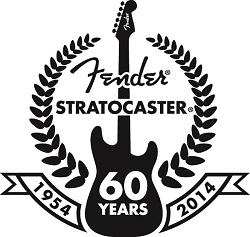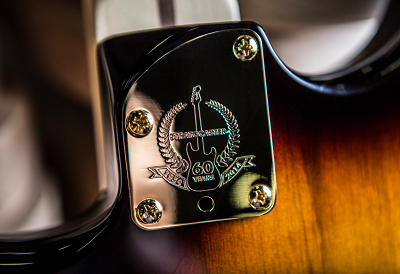2014 marks the 60th anniversary of the Stratocaster. In line with this, Fender takes us back through time to share how the Strat continues to affect our musical landscape decades after it was first released.

Related Feature:
Fender Factory Tour
A Strat is Born
Leo Fender worked on the Strat after the introduction of the Telecaster and Precision Bass guitars in 1951. Both were successful instruments in their own right, but the company founder had his eyes set on a bold new design. The resulting guitar debuted in 1954 and was named by Fender sales chief Don Randall as the “Stratocaster”. The design was “perfected” by 1957 and impressively, it remained largely unchanged ever since, a testament to the guitar’s credibility and the genius of its designer.
The Stratocaster with its improved tonal palette, visual appeal and playability then easily captured the hearts of many players. Fender rightly claims: “An extraordinary new guitar with several ingenious design innovations, the Stratocaster proceeded to revolutionize popular music as an indispensable tool of phenomenal creativity…”
Although the Stratocaster wasn’t really the first of its kind, it is the first that come to mind when people think of an electric guitar. It has the archetypal look that is familiar to both professionals and non-musicians alike. And having been used in countless live performances and recordings by the some of the most talented artists that graced this planet, the Strat went on to become a cultural symbol.
Fender was actually being modest when they said: “‘You see the instrument everywhere, and hardly a day goes by when you don’t hear its signature sound. It was so essentially and remarkably right from the very start in 1954 that it has shaped popular music for 60 years virtually unchanged. A great deal of the music you love—the very soundtrack of your life—was and is made with a Stratocaster.”
The Strat built up an impressive mainstream presence, it was used on popular songs from every era since it was introduced. It is the guitar behind songs that include “That’ll Be the Day” (the Crickets, 1957), “Purple Haze” (the Jimi Hendrix Experience, 1967), “Smoke on the Water” (Deep Purple, 1972), “Pride and Joy” (Stevie Ray Vaughan and Double Trouble, 1983), “Even Flow” (Pearl Jam, 1992), “Dani California” (Red Hot Chili Peppers, 2006), “Get Lucky” (Daft Punk, 2013) and countless other hits.
To celebrate the Stratocaster’s 60th Anniversary, Fender has set up a page that showcases the “Strat Past”, from the mid-’50s to the present. They also provided decade by decade breakdown of notable Stratocaster presence, and you can read it below:
“It didn’t take long for the Stratocaster to catch on, especially after millions got a good look at one when Buddy Holly played his on The Ed Sullivan Show in late 1957. And from the 1960s onward, players have put the Stratocaster to wildly imaginative uses never envisioned by the guitar’s creators and earliest champions. It really has revolutionized popular music everywhere.
The Stratocaster rode the huge vocal and instrumental surf music wave of the early 1960s, exemplified by debut Beach Boys album Surfin’ Safari and the exotic instrumental fury of Dick Dale’s “Misirlou,” both from 1962. Jimi Hendrix caused a sensation with his literally incendiary performance at the Monterey International Pop Music Festival in Monterey, Calif., in 1967, concluding his band’s startling set by smashing his ’65 Stratocaster and setting it aflame onstage. The performance made Hendrix—already popular in the U.K.—a star in the United States.

The 1970s was an especially fertile period for the Stratocaster. As noted, Clapton’s use of the instrument on his 1970 solo debut and Layla and Other Assorted Love Songs drew great acclaim. When the members of Deep Purple watched from their hotel on the shores of Switzerland’s Lake Geneva as the nearby Montreux Casino was destroyed by fire on Dec. 4, 1971, they were inspired by the “fire in the sky” and the smoke drifting over the lake to compose 1972 proto-metal classic “Smoke on the Water,” for which guitarist Ritchie Blackmore created the most imitated Stratocaster riff ever. And among the many great Stratocaster solos crafted by David Gilmour throughout Pink Floyd’s lengthy career, those for “Comfortably Numb” and “Another Brick in the Wall Part 2” from bleakly mesmerizing 1979 masterpiece The Wall are routinely ranked among his greatest.
An especially colorful year for the Stratocaster came in 1983 with two chart-topping comebacks: David Bowie’s Let’s Dance, on which millions of listeners worldwide get their first tastefully blistering earful of a young Texas blues virtuoso named Stevie Ray Vaughan, and Yes’s 90125, on which South African guitarist Trevor Rabin uses his ’62 Strat, most notably for a strikingly angular solo on number-one hit “Owner of a Lonely Heart.”
The Stratocaster entered the 1990s stronger than ever. Kurt Cobain recorded a great deal of industry-changing Nirvana juggernaut Nevermind, released in September 1991, using a Stratocaster. Thus, the same guitar behind the foot-tapping sound of 1957’s “Peggy Sue” was also behind the intensely aggressive sound of the biggest rock phenomena of the modern era, grunge and alt-indie. The Stratocaster also fueled many ’90s tracks by major acts such as Smashing Pumpkins and the Red Hot Chili Peppers.
As it entered the 2000s, the Stratocaster remained on the forefront of modern music propelling songs like The Strokes’ 2001 youthful hit “Last Nite,” Audioslave’s 2003 power anthem “Show Me How To Live,” John Mayer’s 2006 lilting “Gravity,” Cee Lo Green’s 2010 “Forget You,” and the instantly recognizable song of 2013, Daft Punk’s “Get Lucky,” which features funk master Nile Rodgers’ 1959 Fender Stratocaster known as The Hitmaker for producing the sounds behind some of the biggest-selling albums of all time.”
Now with 60 years of solid experience behind the Strat, Fender still considers it as the future of electric guitar. In the face of countless “clones”, Fender continues to introduce models with the latest electronic and digital technology, while also catering to players that prefer traditional builds.
Fender summarizes that the new Stratocaster models “will deliver electrifying new playing experiences to guitarists everywhere and usher the world’s greatest electric guitar into a bright and bold new era.”
Related Articles:
MXR 40th Anniversary Legacy Documentary
Fender Fishman TriplePlay Stratocaster HSS
A Fender Stratocaster topped our list of the best Electric Guitars for under $500

